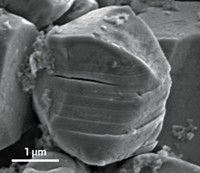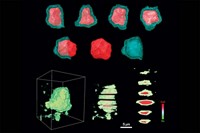Advertisement
Grab your lab coat. Let's get started
Welcome!
Welcome!
Create an account below to get 6 C&EN articles per month, receive newsletters and more - all free.
It seems this is your first time logging in online. Please enter the following information to continue.
As an ACS member you automatically get access to this site. All we need is few more details to create your reading experience.
Not you? Sign in with a different account.
Not you? Sign in with a different account.
ERROR 1
ERROR 1
ERROR 2
ERROR 2
ERROR 2
ERROR 2
ERROR 2
Password and Confirm password must match.
If you have an ACS member number, please enter it here so we can link this account to your membership. (optional)
ERROR 2
ACS values your privacy. By submitting your information, you are gaining access to C&EN and subscribing to our weekly newsletter. We use the information you provide to make your reading experience better, and we will never sell your data to third party members.
Energy Storage
Video: Battery scientists tackle the dendrite problem
To make powerful lithium-metal batteries, researchers must find ways to stop these spiky structures from growing
by Kerri Jansen
December 13, 2019
| A version of this story appeared in
Volume 97, Issue 48
Lithium-ion batteries have revolutionized the way we power our gadgets, and they even nabbed the Nobel Prize in Chemistry this year. But scientists want to make even more powerful versions. Replacing the graphite anodes in Li-ion batteries with lithium-metal ones could double the batteries’ charge capacity. But dendrites—spiky lithium structures that can accumulate on the anode during charging—can short-circuit batteries, posing a serious safety hazard. So scientists are working to master the dendrite problem by investigating how the structures grow and by developing solutions to suppress them, such as building physical barriers or using solid electrolytes to halt dendrite growth. Watch this video to learn more.
Subscribe to our YouTube channel to catch all of our chemistry news videos.
Read Mitch Jacoby’s story about dendrite research at Pacific Northwest National Laboratory here.
Learn more about dendrite-related research at the links below:
A solid new approach to sodium batteriesImaging lithium dendrite growth via cryo-electron microscopy
The following is the script for the video. We have edited the interviews within for length and clarity.
Kerri Jansen: Lithium-ion batteries are in our phones, in our cars, and they even won the Nobel Prize in Chemistry this year. They’ve revolutionized the way we power our gadgets. But scientists want to make batteries that are even more powerful. One way to do that would be to replace their graphite anodes with ones made from lithium metal. That swap could double the batteries’ charge storage capacity. But lithium metal has some problems. For example, as a battery charges, lithium ions can deposit irregularly on the anode, forming spiky structures called dendrites that can grow long enough to reach the other electrode and short-circuit the battery, potentially causing a fire. This is a bigger problem for lithium metal than for other anode materials like graphite. And the dendrite problem has limited the practical applications for lithium metal batteries thus far. Here’s battery researcher Neil Dasgupta.
Neil Dasgupta: For decades now, we’ve known that lithium metal is sort of, you know, one of our ambitious goals to replace graphite, because of those energy density benefits. But we haven’t really gotten there. We still don’t have a full understanding of when, where and why they actually grow.
Kerri: Neil’s team is among the many groups working to understand how these dendrites grow so they can stop them. In this video, I’ll tell you about a team at Pacific Northwest National Lab that’s examining how dendrites grow. And then I’ll point out two strategies that are being developed to impede these pesky structures.The researchers at PNNL used a transmission electron microscope to record the growth of lithium dendrites inside a custom-made electrochemical cell. They watched as lithium formed a clump on the surface of the anode, then suddenly sprouted into a needle-like column, which the researchers call a whisker. The team first recorded how dendrites grew—or didn’t grow—in different gases. Then the researchers tested more realistic conditions—liquid electrolyte solutions. The experiments revealed how changing the electrolyte could potentially reduce dendrite growth.
C&EN’s battery master Mitch Jacoby has the scoop on those findings; I’ll put a link to his article in this video’s description.
The PNNL team also measured how the lithium whiskers responded to pressure. One of the electrochemical cell’s electrodes was the arm of an atomic force microscope. This arm let the scientists measure the forces that made the whiskers bend and buckle. Scientists could use this information to develop films that physically block dendrite growth. Remember how I said we’d talk about strategies to stop dendrites in their tracks? Adding a barrier film is one of them. But there’s still room for improvement, so some researchers are taking the idea a step further. A team at the University of Michigan designed a barrier that suppresses dendrite growth not just by physically blocking them, but also by altering the conditions around dendrite tips where growth is concentrated.
The material is a soft polymer film that is polarized and piezoelectric—meaning it generates a voltage when the film is deformed. The film sits on top of the battery’s anode. And when a lithium dendrite presses on the film, the voltage repels more lithium ions from piling up at that spot. This prevents the lithium from forming sharp tips that can penetrate the barrier. The team reports that a coin-type battery cell made with the material survived 1000 cycles without short circuiting, a standard test for a new battery material.
The work we’ve talked about so far involves batteries with liquid electrolytes. But dendrites are also a problem in batteries that use solid electrolytes. Solid electrolytes avoid the need to use flammable solvents, which makes the battery safer. But uncontrolled dendrites can still short-circuit the battery and potentially cause them to fail. Researchers think they can solve that problem by tuning the solid electrolyte’s properties. This is strategy 2 on our list.
At the Toyota Research Institute of North America, researchers recently demonstrated a battery with a lithium metal anode, solid lithium thiophosphate electrolyte, and sulfur cathode. Sulfur is another high-storage-capacity electrode material and—bonus—it’s cheap. As for the battery’s ability to resist dendrites, the Toyota researchers noted a relationship between dendrite growth and the electrolyte’s ability to conduct ions. Here’s group leader John Muldoon.
John Muldoon: Ionic conductivity is very important because as you increase the ionic conductivity of the solid electrolyte, you can operate at higher currents without the formation of dendrites.
Kerri: And the researchers found that by heat-treating the material at a specific temperature, they can force it to take on a specific crystal structure. By choosing a structure with a high ionic conductivity, they can delay the onset of dendrite growth. With the electrolyte, a battery completed 95 cycles of high-current charging without short circuiting. Of course, this is just a small sample of ways researchers are tackling the dendrite problem. Check out the links in this episode’s description for more.
Fin.
Music: “Oceans” by Rex Banner.





Join the conversation
Contact the reporter
Submit a Letter to the Editor for publication
Engage with us on Twitter